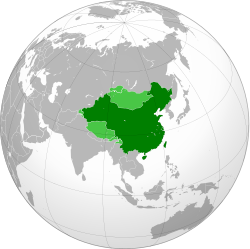Republic of China (1912–1949)
The Republic of China (ROC) was a country that existed between 1912 and 1949. It is now the People's Republic of China. It was created in January 1912 after the Xinhai Revolution, which overthrew the Qing dynasty. The Republic's first president was Sun Yat-sen. Sun's party, the Kuomintang (KMT) won the parliamentary election in December 1912.
Republic of China 中華民國 Zhonghua Minguo | |||||||||||||
|---|---|---|---|---|---|---|---|---|---|---|---|---|---|
| 1912–1949 | |||||||||||||
Anthem:
| |||||||||||||
 Location and maximum extent of the territory claimed by the Republic of China (1945). | |||||||||||||
| Capital | Beijing (1912–1928) Nanjing (1927–1949) Chongqing[a] (1937–1946) | ||||||||||||
| Largest city | Shanghai | ||||||||||||
| Official languages | Standard Chinese | ||||||||||||
| Recognised national languages | Tibetan Chagatai/Uighur Manchu Mongolian and other languages | ||||||||||||
| Official script | |||||||||||||
| Religion | see Religion in China | ||||||||||||
| Government | Federal semi-presidential republic under Beiyang rule (1912–1928) One-party state under a military dictatorship (1928–1946) Unitary parliamentary constitutional republic (1946–1949) | ||||||||||||
| President | |||||||||||||
• 1912 | Sun Yat-sen (first, provisional) | ||||||||||||
• 1949–1950 | Li Zongren (last in Chinese mainland, acting) | ||||||||||||
| Premier | |||||||||||||
• 1912 | Tang Shaoyi (first) | ||||||||||||
• 1949 | He Yingqin (last in Chinese mainland) | ||||||||||||
| Legislature | Parliament | ||||||||||||
| National Assembly | |||||||||||||
| Legislative Yuan | |||||||||||||
| History | |||||||||||||
| 10 October 1911[b]–12 February 1912[c] | |||||||||||||
| 1 January 1912 | |||||||||||||
• Beiyang government in Peking | 1912–1928 | ||||||||||||
| 1926–1928 | |||||||||||||
• Nationalist government in Nanking | 1927–1949 | ||||||||||||
| 1927–1936, 1946–1950[d] | |||||||||||||
| 7 July 1937[e]–2 September 1945[f] | |||||||||||||
• People's Republic of China proclaimed | 1 October 1949 | ||||||||||||
| 7 December 1949 | |||||||||||||
| Area | |||||||||||||
| 1912 | 11,077,380 km2 (4,277,000 sq mi) | ||||||||||||
| 1946 | 9,676,204 km2 (3,736,003 sq mi) | ||||||||||||
| Population | |||||||||||||
• 1912 | 432,375,000 | ||||||||||||
• 1920 | 472,000,000 | ||||||||||||
• 1930 | 489,000,000 | ||||||||||||
• 1946 | 535,418,000 | ||||||||||||
• 1949 | 541,670,000 | ||||||||||||
| Currency | |||||||||||||
| Time zone | UTC+5:30 to +8:30 (Kunlun to Changpai Standard Times) | ||||||||||||
| Driving side | right | ||||||||||||
| ISO 3166 code | TW | ||||||||||||
| |||||||||||||
| Today part of | |||||||||||||
Populations from http://www.populstat.info/Asia/chinac.htm | |||||||||||||
But Sun soon gave the position to Yuan Shikai, the leader of the Beiyang Army. The Beiyang Army also controlled the Beiyang government (which controlled Mongolia).
Between late 1915 and early 1916, Yuan Shikai called himself the Emperor of China. But people did not like it (National protection war).
After Yuan died in 1916, the Beiyang government was further weakened by a brief restoration of the Qing dynasty. Various groups in the Beiyang Army claimed independence and fought with each other during the Warlord Era.
In 1921, the KMT created a rival government in Canton, supported by the Communist Party of China (CPC),
North China was overtaxed and had too many fighting warlords. So its economy died between 1927 and 1928.
General Jiang Jieshi (Chiang Kai-Shek) became the KMT leader after Sun's death. Jiang started the Northern Expedition in 1926 and overthrew the Beiyang government in 1928. In April 1927, Jiang created a nationalist government in Nanjing and massacred Communists in Shanghai. With the support from the USSR. The CPC into armed rebellion, starting the Chinese Civil War.
China experienced industrialization and modernization but suffered conflicts between the Nationalist government in Nanjing, the CPC, warlords, and the Empire of Japan.
Eventually the Chinese unified to fight against their common enemy: the Japanese. In 1937 the Imperial Japanese Army invaded China in 1937. The Second Sino-Japanese War began.
In August of 1945, Japan surrendered at the end of World War II.
In 1946, the Chinese Civil War between the KMT and CPC restarted.
In 1949, the CPC defeated the KMT and started the People's Republic of China (PRC).
Jiang Jieshi and the KMT fled to Taiwan.
Notes
change- ↑ As wartime provisional capital during the Second Sino-Japanese War.
- ↑ Wuchang Uprising started.
- ↑ The last monarch of the Qing dynasty, Xuantong Emperor abdicated, Qing dynasty formally ended.
- ↑ Chinese Communist Revolution.
- ↑ Marco Polo Bridge Incident started.
- ↑ Surrender of Japan at the end of World War II.


